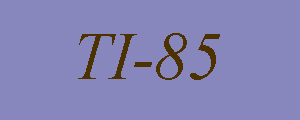TI-85 Program: Estimating Limits
This is a program for the TI-85 which will estimate limits numerically.
To use the program, you input a formula for a function F, a value
A for
the limit point (the number that x is to approach) and a step
size S which governs how rapidly the chosen values are desired to
close in on the limit point. (S should be a positive number less than 1.)
The program starts by evaluating the function at the x-values
A+1 and A-1. It then chooses values closer to A on the right and the left
(in that order) in proportion to the step size. For example if the step size
is .1 then the successive points where the function is evaluated
are A+1, A-1, A+.1, A-.1, A+.01,
A-.01, etc...
Notice that the odd values in the list approach the right hand limit while the
even ones approach the left hand limit. To see a simple example where the
right and left hand limits are different, try inputting the function with
equation
F(x) = (x>1)-(x<1)
and taking the limit point to be 1.
:InpSt "The function is: ",F
:St>Eq(F,FCN)
:Input "The limit point is: ",A
:Input "The step size is:",S
:A+1->XR
:A-1->XL
:Lbl HERE
:For(J,0,3,1)
:evalF(FCN,x,XR)->YR
:evalF(FCN,x,XL)->YL
:Disp YR
:Disp YL
:A+S*(XR-A)->XR
:A+S*(XL-A)->XL
:End
:Pause
:Goto HERE
In some cases, this program will produce significant round-off error.
For instance, try to determine the limit as x approaches 0
of the function F(x) = (sec(x) - 1)/x (using say a step size of .2).
(The TI-85 is not programmed to understand sec(x), you will need to
enter it in a different way such as cos(x)^(-1).)
Notice that round-off error comes into play very rapidly in this example.
Can you understand why?
(The limit should equal 0; it represents the
slope of the secant line to y = sec(x) at the point (0,1).)
[In the code typed above, the symbols
"St>Eq(" and "evalF("
can be found on the CATALOG menu. The symbol
"->" is accessed
using the "STO>" key which is the second key from the lefthand
bottom of the calculator. Many of the other command words can be
found on the I/O and CTL menus. The greater than and less than symbols
may be found on the TEST menu.]

This document was created in September, 1996
and last revised on August 15, 1998.
Your questions, comments or suggestions are welcomed.
Please direct correspondence to:
Andy Miller
Department of Mathematics
University of Oklahoma
e-mail: amiller@ou.edu
URL: http://www.math.ou.edu/~amiller/ti85/limit.htm
